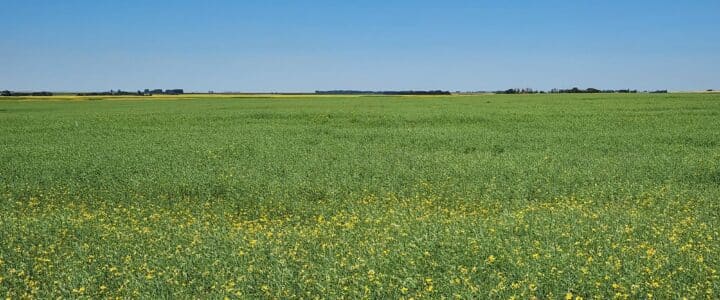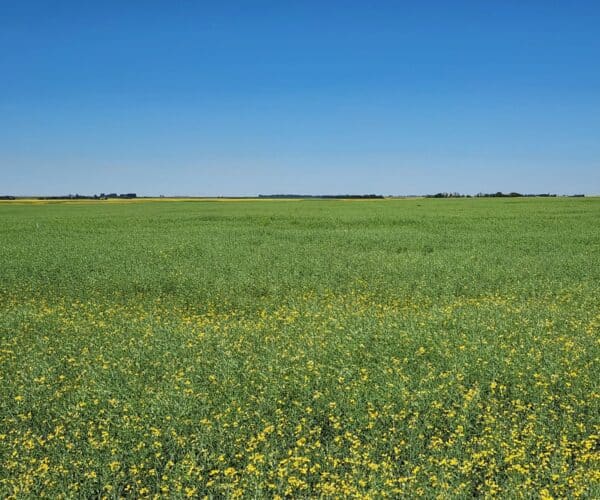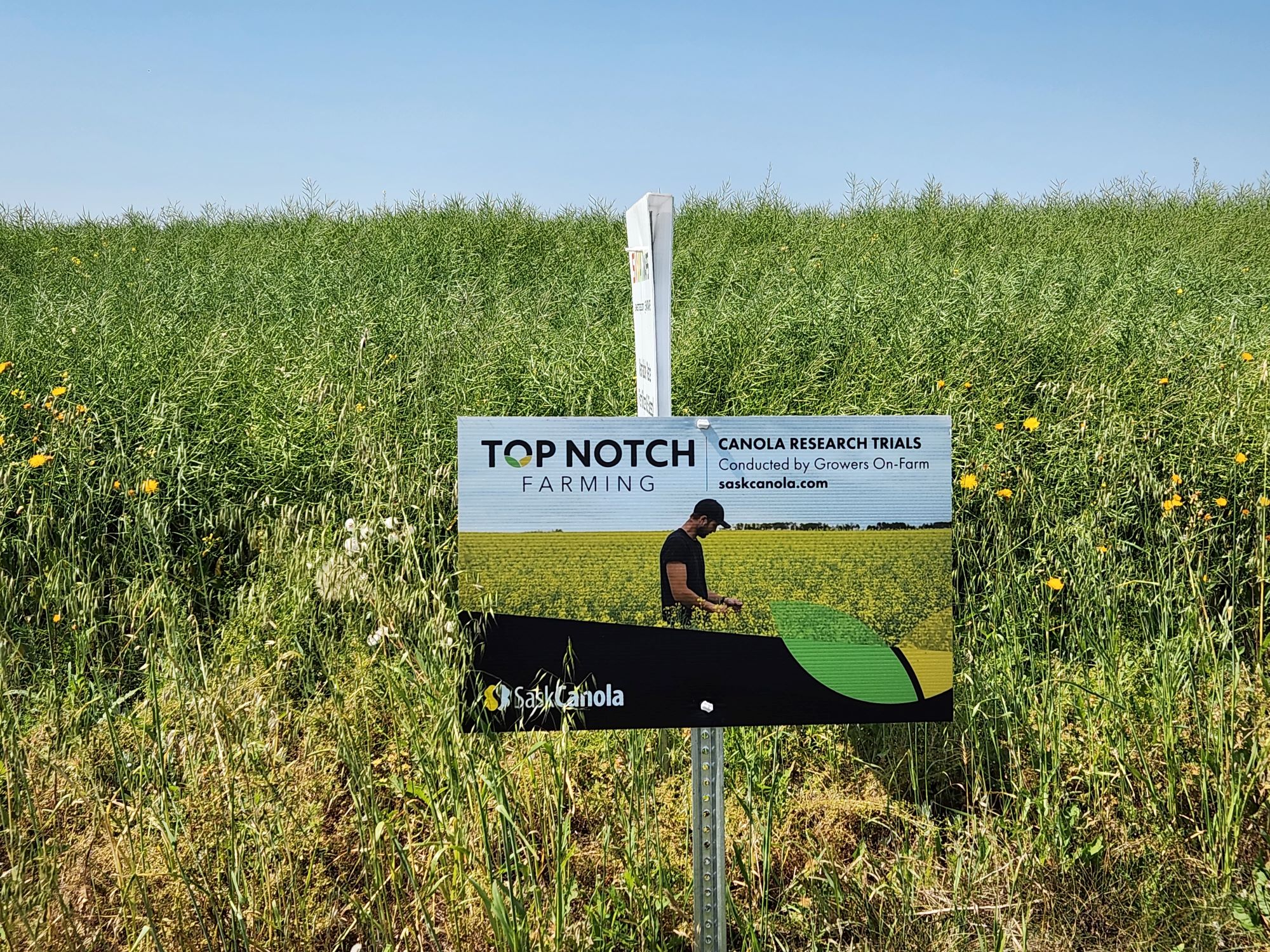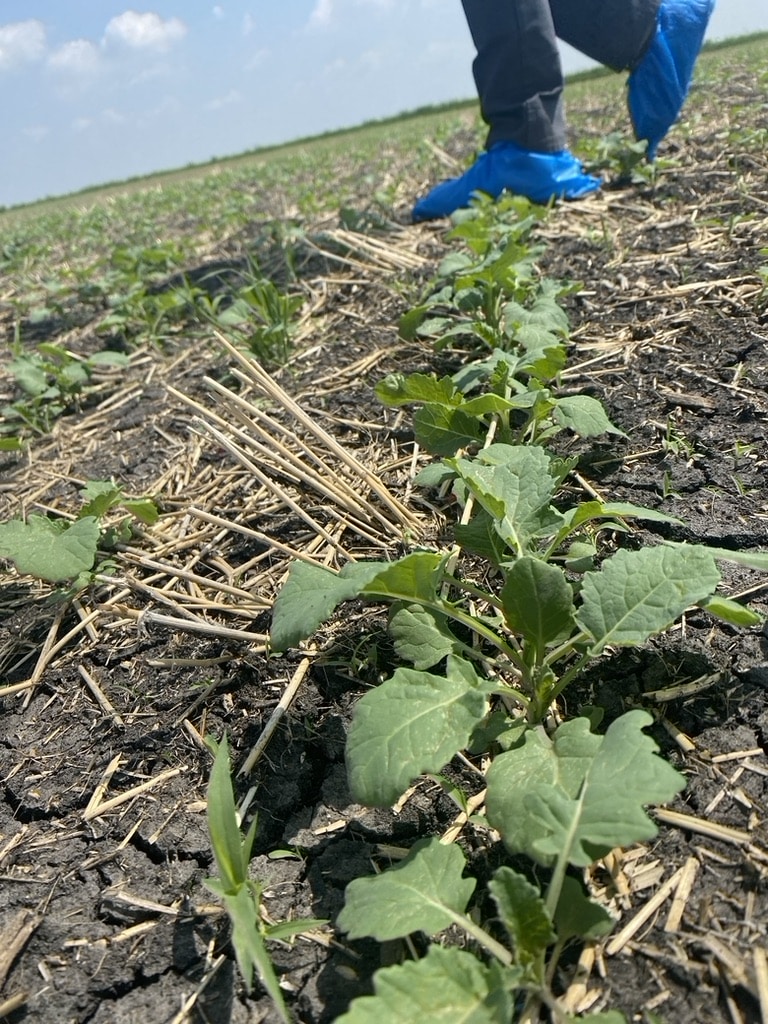Photo credit: SaskCanola
The revised crop nutrient uptake and removal guidelines for Western Canada reported average whole canola plant nitrogen uptake rates of 2.38 (±1.26) pounds of nitrogen per bushel of grain produced. With such notable nitrogen requirements, there’s interest in ways to potentially reduce fertilizer application amounts while still providing the plant with its required nutrition.
One potential way to achieve this is could be through breeding efforts, as the Biological nitrogen fixation in canola project is investigating. An alterative option is an effective biological product with the ability to facilitate nitrogen fixation (obtain nitrogen from the atmosphere) in non-legume crops, such as canola. However, since there is little publicly available data regarding the performance of such products, SaskCanola’s Top Notch Farming field-scale research trials tested a commercially available, foliar-applied nitrogen-fixing bacteria product (Envita®) in canola. The goal was to determine if there are agronomic and economic benefits of applying this product.
Apply this on your farm
- Check the revised Prairie nutrient guidelines and calculator.
- Review SaskCanola’s Top Notch Farming trial results.
- Factor in the N-fixation in non-legumes conclusions for wheat, soybean and canola.
- Consider these nitrogen-fixing product performances.
- Sign-up for a 2024 on-farm trial.
Nitrogen fixation on-farm canola trials

Spring soil samples were collected at all nine locations in Saskatchewan prior to seeding and fertilizer application to assess residual soil nutrient (N03) levels. A minimum of 12 soil cores were collected throughout the trial area, separated by 0-6 inch and 6-24 inch depths.
All strip plots were managed the same agronomically including seeding date, variety, seeding depth, seed treatment, and pesticide application. Where applied, Envita® was either tank-mixed at herbicide timing or applied (according to label recommendations) as a separate pass.
Option A trials (two treatments)
All strips (8 in total) were seeded at the normal nitrogen fertilizer rate determined by the producer and their agronomist based on their management practices and soil sampling data. Four Envita® treatment strips were established using the provided randomized field plan. Another four strips that had no Envita® applied were left as the untreated checks.
Option A trials were carried out at Carrot River, Indian Head Agricultural Research Foundation (IHARF), Maidstone, Shaunavon and Vibank, Saskatchewan.
Option B trials (four treatments)
Half (6) of the total (12) strips were either seeded with the normal nitrogen fertilizer rate or a reduced nitrogen rate (of 90 percent or less of the normal rate). Envita® was applied in three strips that had the normal nitrogen fertilizer rate and three strips that had the reduced nitrogen fertilizer rate, using the provided randomized field plan (and three strips were left as the untreated checks within each of the nitrogen treatments).
Option B trials were carried out at Davidson, Indian Head, Luseland, and Wynyard, Saskatchewan. The Davidson and Wynyard sites also included a ‘low nitrogen rate’ treatment in addition to the ‘reduced nitrogen rate’ and ‘normal nitrogen rate’ treatments.
Canola yield, oil and protein content results
In addition to collecting spring plant density, observations and weather data, canola yield (using weigh wagons or grain carts with a scale) and quality (oil and protein content) was determined for each plot. The 2024 suggested retail price for Envita® that was used in the economic analysis was $16.48 per acre.
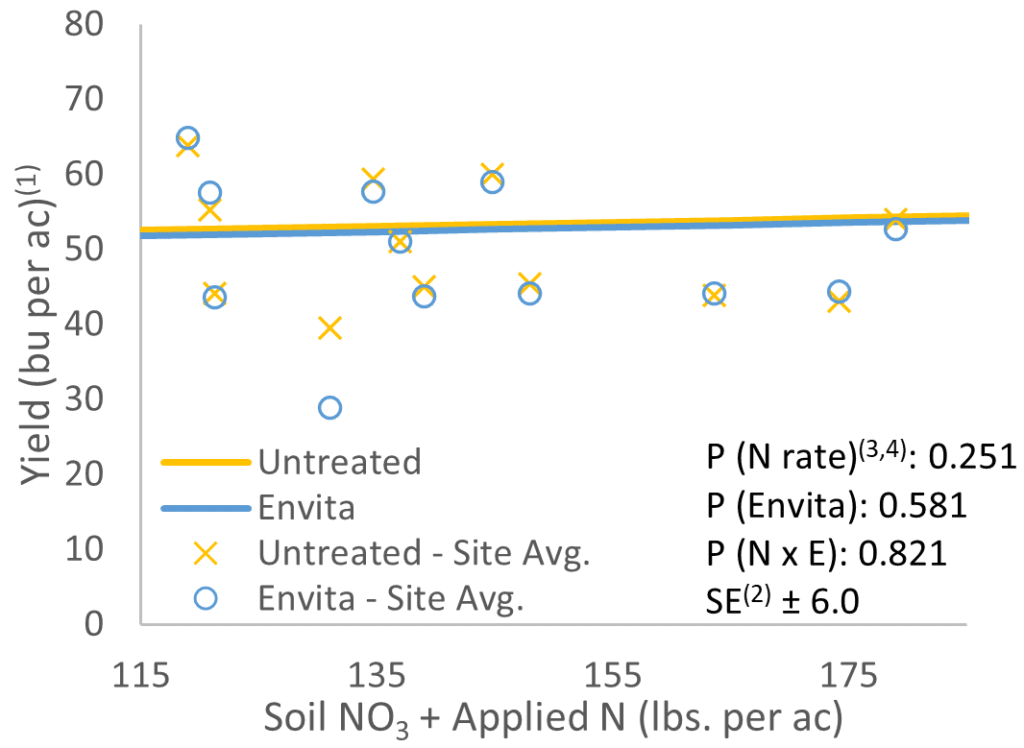
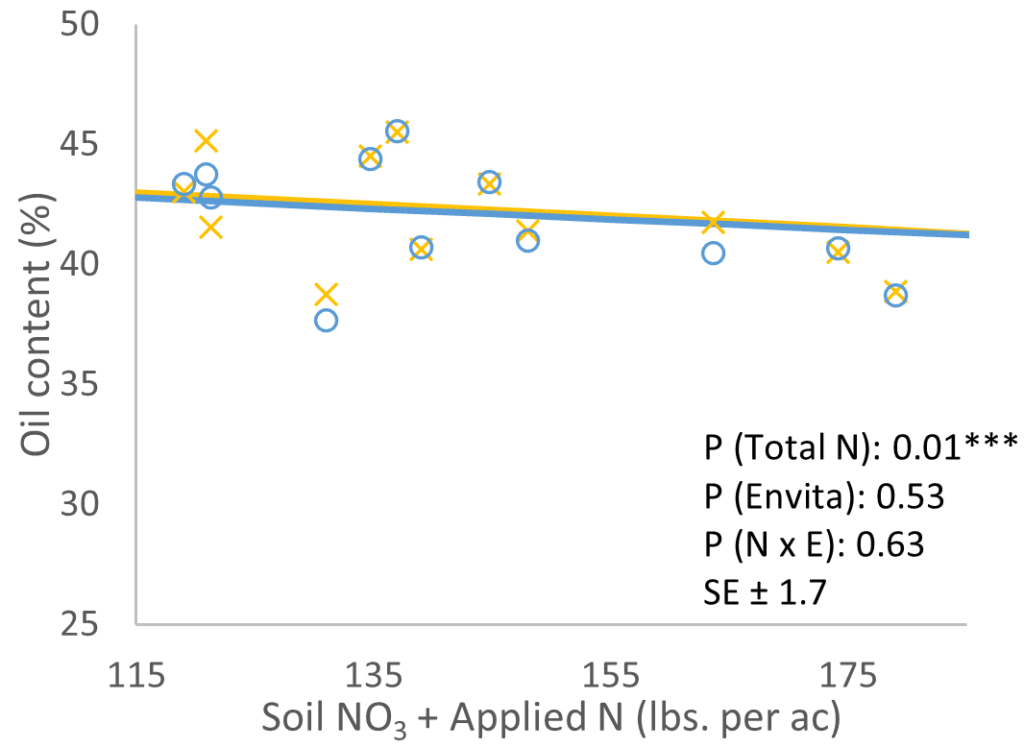
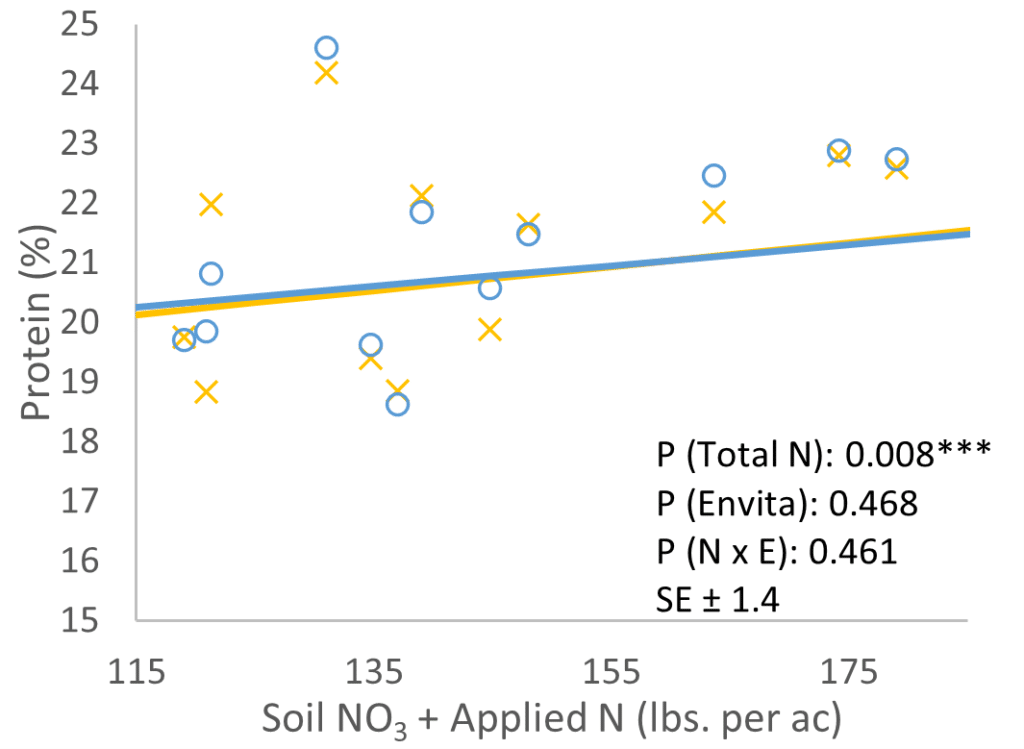
Considering individual site data, there were very few significant impacts of the treatments on canola yield, oil content or protein content. The only sites that reported significant impacts were at Davidson and Wynyard, the only two locations which included three nitrogen rate treatments (a ‘low nitrogen rate’, ‘reduced nitrogen rate’ and ‘normal nitrogen rate’ treatment). More specifically:
- Nitrogen rate was found to have a significant impact on protein and oil content (P<0.05) and there was a significant interaction, to a lesser degree (P<0.1) between the nitrogen rate and the Envita® application at the Davidson site.
- Nitrogen rate was found to have a significant impact on yield (P<0.1) and the Envita® application had a significant (P<0.1) impact on protein content at the Wynyard site.
Overall (considering all sites) there was no difference detected in yield in response to Envita® application or nitrogen rate under the conditions experienced across the trials this growing season.
Agronomic and economic conclusions
When data from all sites was combined to assess the impact of the Envita® application and nitrogen rates, there were no significant impact on canola yield (and therefore no significant economic benefit) under the conditions experienced across the trials this growing season. Protein increased significantly and oil content decreased significantly with the greater nitrogen rates, but did not differ significantly with Envita® application.
At all sites the most economical treatment (between the inclusion of the nitrogen-fixing bacteria product or the untreated check) was the untreated check.
For management details, environmental conditions, and results from individual sites, see the Saskatchewan on-farm research trials 2023: Foliar N-Fixing Biological Trial for Canola report. The Saskatchewan bulletin in the 2023 Canola Digest: Science Edition also provides some background information on these trials.
Additional nitrogen fixation research

Outcomes with wheat, soybean and canola
The Advanced N management for canola, wheat and soybean: Evaluation of a new biological for N-fixation in non-legumes research, which also evaluated a microbial inoculant containing the same free-living nitrogen-fixing bacteria in the Envita® product (Gluconoacetobacter diazotrophicus) for its ability to biologically fix nitrogen for wheat, soybean and canola, reported similar conclusions to Saskatchewan’s on-farm trials. Key findings from this research included:
- The free-living nitrogen-fixing bacteria (G. diazotrophicus) did colonize the root and shoot tissues of wheat, canola and soybean in many, but not in all, cases. However, the presence of the bacteria did not often translate into nitrogen fixation.
- In many cases, the percentage of nitrogen in the plants that were colonized with the bacteria was actually lower than the plants that weren’t inoculated (the control plants), which could be from the bacteria using the nitrogen at the expense of the plant.
- The most effective of the three inoculation methods evaluated was soaking the seed in inoculant during germination, followed by foliar application and finally applying the inoculant to the seed. Unfortunately this soaking method is also the least practical method to implement on a large scale.
- An alternative soil soaking method, where a liquid formulation of the inoculant is applied to the seed row after planting has potential. However, given the time restrictions that farmers are faced with during seeding and spraying, it is difficult to imagine that this could be implemented on a wide-scale.
- Therefore, while prior studies have demonstrated that inoculation with G. diazotrophicus improves tissue nitrogen in corn, transferring that information/technology to wheat, soybean and canola has proven challenging and did not generally translate to enhanced biological nitrogen fixation in these western Canadian crops.
Conclusions from corn, spring wheat, sugar beet and canola trials
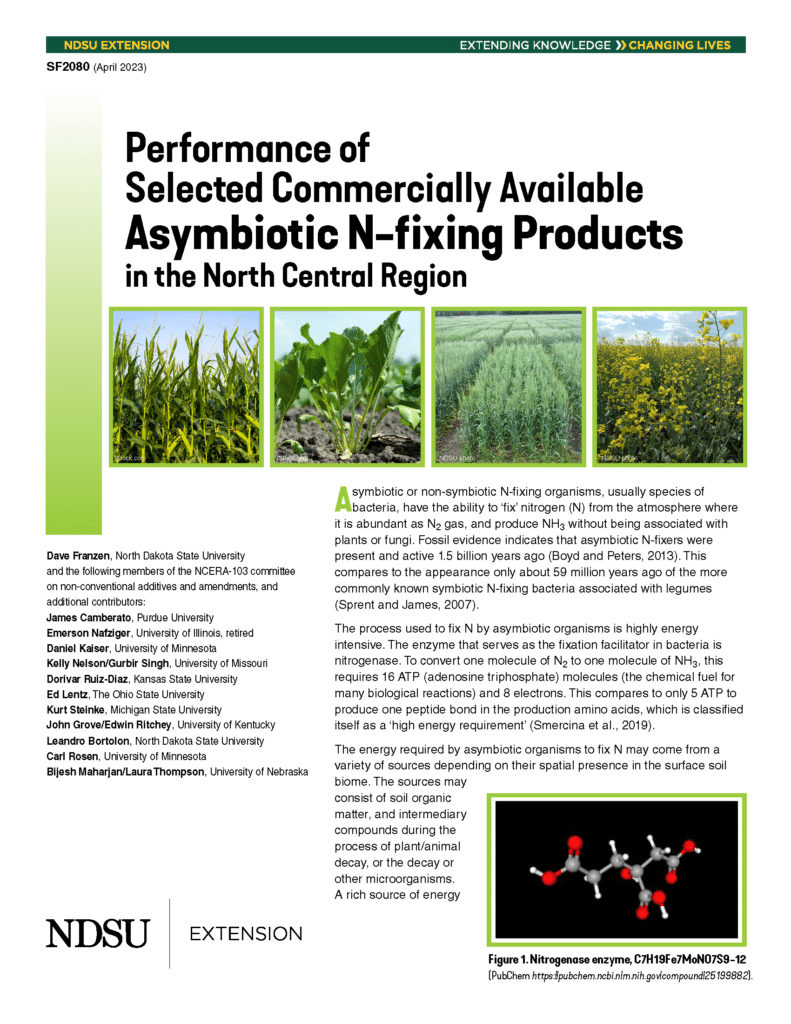
The Performance of Selected Commercially Available Asymbiotic N-fixing Products in the North Central Region report had results along the same lines:
- Of the 61 site-years of nitrogen rate trials with and without the use of biological nitrogen-fixing products were conducted in corn, spring wheat, sugar beet and canola in 10 states within the North Central Region of the U.S, 59 site-years had no yield increase with use of the product over nitrogen rate alone. The two site-years that had yield increases were in corn and were due to product use over the nitrogen rates alone.
- This report cautioned that, “given the low rate of positive benefits to the use of these products, growers should be skeptical of products that claim to provide asymbiotic/nonsymbiotic nitrogen-fixation for the purpose of allowing a farmer to decrease fertilizer nitrogen rate”.
- The researchers acknowledge the benefit of farmer curiosity on new ideas, but recommended testing products on their own farm in a replicated manner and considering unbiased data before adopting them across the farm.
Get involved in 2024
Both Manitoba and Saskatchewan are running on-farm research trials in 2024. Consider participating in these because they provide the chance to:
- Join a network of growers and agronomists who are interested in field-scale research and sharing on-farm results.
- Get statistically valid results with your equipment under your farm conditions and management practices to help you make decisions on your farm.
- The chance to work with a research specialist or agronomist who will help support you through every step of the research process throughout the season.
Saskatchewan on-farm trials
Applications are now being accepted for SaskCanola’s Top Notch Farming 2024 canola trials. The protocols include: a foliar-applied nitrogen-fixing biological trial, a seeding rate trial and an enhanced efficiency fertilizer trial.
For more information, or to participate in the program, contact: Kaeley Kindrachuk, Agronomy Extension Specialist with SaskCanola.
Manitoba on-farm trials
Building on the results in the 2023 Canola On-Farm Research Program Report (which was featured in the Intriguing product and rate outcomes from on-farm trials Hub blog), the Manitoba Canola Growers’ on-farm program will continue in 2024. They are planning to continue running seed-placed fertilizer, seeding rate and nitrogen rate trials in 2024 as well as adding in a cover cropping for flea beetle management protocol in 2024.
If you are interested in participating in, or have a trial idea for Manitoba Canola Growers’ on-farm program please contact Amy Delaquis, Research Manager with the Manitoba Canola Growers.
More about the complex canola microbiome
To learn more about the environment in a canola field under the soil surface:
- Check out the Bacterial microbiome associated with the rhizosphere and root interior of crops in Saskatchewan paper.
- Investigate the Enhancing the beneficial root microbiome in canola research, which documented canola microbiomes from bacteria, fungi, and archaea communities. More specifically, they reported:
- Canola microbiomes around the roots were different from those in the rhizosphere and canola microbiomes were significantly different from wheat and pea crops.
- The research team highlighted the potential plant growth-promoting rhizobacteria among those microorganisms by correlating the core microbiome members in the Canadian Prairies with canola yield.
- A preceding crop of lentil substantially increased biological N2 fixation and reduced denitrification in the following oilseed crops.
Published February 29, 2024


